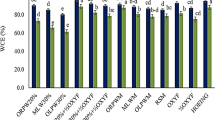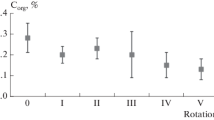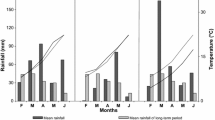Abstract
Disposal of urban, agricultural and industrial organic residues impliesan increasing problem because of all the economic and environmentalrepercussions involved. One of the most adequate ways of managing this problemis the agricultural use of these wastes as organic amendments. Three organicresidues (AC, olive mill waste water sludge compost; MWC, municipal solid wastecompost; and PS, paper mill sludge) were used in a 3-year field experimentinvolving orange production. The effect of their application on crop productionand on soil quality was investigated. Soil samples (0–20 cm depth)collected 11 months after the last soil amendment were analysed for: pH and EC,Kjeldahl-N, available-P, available-K, total organic carbon, humic substances,dehydrogenase, phosphatase, β-glucosidase, urease andbenzoyl-argininamidehydrolysing protease (BAA-protease) activities. Generally, the application of the MWC and PSincreased orange yield when compared to control. Moreover, total organic carbonand humic substances significantly increased in soils treated with all theorganic amendments. Organic fertilisation increased the Kjeldahl-N andavailable-P contents of the soil. The application of the organic residues also causedsignificant increases in dehydrogenase, β-glucosidase, urease andBAA-protease activities of the soil. Significant positive correlations (p <0.01) between these enzymatic activities and total organic carbon were foundforall treatments. Significant positive correlation between dehydrogenase, urease,β-glucosidase, and BAA-protease and orange yield was also found. However,a clear inhibition of phosphatase activity was observed in soils treated withPS. The results indicate that the repeated application to the soil of moderateamounts of organic amendments has positive effects on the chemical andbiochemical properties of the soil, as well as on the orange yield.
Similar content being viewed by others
References
Bellamy K.L., Chong C. and Clin R.A. 1995. Paper sludge utilizasoil tion in agriculture and container nursery culture. J. Environ. Qual. 24: 1074–1082.
Barker A.V. 1997. Composition and uses of compost. In: Rechling J.E. and Mackinnon H.C. (eds), Agricultural Uses of By-products and Wastes Vol. 10. American Chemical Society, Washington, DC, ACS Symp. Series No. 668, pp. 140–162.
Cabral F. and Vasconcelos E. 1993. Agriculture use of combined primary/secondary pulp-mill sludge. Agrochimica 37: 409–417.
Ceccanti B. and García C. 1994. Coupled chemical and biochemical methodologies to characterize a composting process and the humic substances. In: Senesi N. and Miano T. (eds), Proc. 6th Int. Meeting of Int. Humic Substances Society, IHSS. Elsevier, Monopoli, Bari, pp. 20–25.
Chunderova A.I. and Zubeta T. 1969. Phosphatase activity in dernopodzolic soils. Pochvovendenie 11 (Soils Fert. 33:2092): 47–53.
Costa F., García C., Hernández T. and Polo A. 1991. Residuos orgánicos urbanos. Manejo y utilizacion, Caja Murcia, Murcia.
Dick R.P. 1994. Soil enzyme activities as indicators of soil quality. Soil Sci. Soc. Am. J. 35: 107–124.
Entry J.A., Wood B.H., Edwards J.H. and Wood C.W. 1997. Influence of organic by-products and nitrogen source on chemical and microbiological status of an agricultural soil. Biol. Fertil. Soils 24: 196–204.
FAO UNESCO 1988. Soil map of theWorld.World Soil Resources Report 60. FAO, Rome, Italy.
Giusquiani P.L., Pagliai M., Gigliotti G., Businelli D. and Benetti A. 1995. Urban waste compost: effects on physical, chemical and biochemical properties of soil. J. Environ. Qual. 24: 175–182.
Hesse P.R. 1971. A Textbook of Soil Chemical Analysis. John Murray, London.
James B.R. and Aschmann S.G. 1992. Soluble phosphorus in a forest soil Ap horizon amended with municipal wastewater sludge or compost. Commun. Soil Sci. Plant Anal. 23: 861–875.
Madejón E., López R., Murillo J.M. and Cabrera F. 2001. Agricultural use of three (sugarbeet) vinasse composts: effect on crops and chemical properties of a Cambisol soil in the Guadalquivir river valley (SW Spain). Agric. Ecosyst. Environ. 84: 55–65.
Martens D.A., Johanson J.B. and Frankenberger W.T. 1992. Production and persistence of soil enzyme with repeated addition of organic residues. Soil Sci. 153: 53–61.
Masciandaro G., Ceccanti B. and García C. 1997. Changes in soil biochemical and cracking properties induced by “living mulch systems”. Can. J. Soil Sci. 77: 579–587.
Moreno J.L., García C. and Hernández T. 1998. Changes in organic matter and enzymatic activity of an agricultural soil amended with metal-contaminated sewage sludge compost. Commun. Soil Sci. Plant Anal. 29: 2247–2262.
Müller U. and Wegener P. 1988. Interaction of humic substances with biota. In: Frimmel F.H. and Christman R.F. (eds), Humic Substances and their Role in the Environment. John Wiley & Sons, New York, pp. 179–192.
Muse J.K. and Mitchell C.C. 1995. Paper mill boiler ash and lime by-products as soil liming materials. Agron. J. 87: 432–438.
Nannipieri P., Ceccanti B., Cervelli S. and Matarese E. 1980. Extraction of phosphatase, urease, protease, organic carbon and nitrogen from soil. Soil Sci. Soc. Am. J. 44: 1011–1016.
Nannipieri P., Pedrazzini F., Arcara P.G. and Piovanelli C. 1979. Changes in amino acids, enzyme activities and biomass during utilizasoil microbial growth. Soil Sci. 127: 26–34.
Olsen S.R., Cole C.W., Watanabe F.S. and Dean L.A. 1954. Estimation of available phosphorus in soils by extraction with sodium bicarbonate. US Dept. of Agriculture, Circular 939.
Pascual J.A., Ayuso M., García C. and Hernández T. 1997. Characterization of urban wastes according to fertility and phytotoxicity parameters. Waste. Manage. Res. 15: 103–112.
Richards L.A. 1954. Diagnosis and improvement of saline and alkali soils. USA Department of Agriculture Handbook 60. USDA Government Printing Office, Washington, DC.
Rodella A.A., Fischer K.R. and Alcarde J.C. 1995. Cation exchange capacity of an acid soil as influenced by different sources of organic litter. Commun. Soil Sci. Plant Anal. 26: 1961–1967.
Salam A.K., Desvia Y., Sutanto E., Syam T., Nugroho S.G. and Kimura M. 1999. Activities of soil enzymes in different land-use systems in middle terrace areas of Lampung province, South Sumatra, Indonesia. Soil Sci. Plant Nutr. 45: 89–99.
Skujins J. 1976. Enzymes in soil. In: Laren A.D. and Mc Peterson G.H. (eds), Soil Biochemistry. Marcel Dekker, New York.
Skujins J. 1978. History of abiontic soil enzyme research. In: Burns R.G. (ed.), Soil Enzymes. Academic Press, New York.
Tabatatabai M.A. 1994. Soil enzymes. In: Mickelson S.H. and Bigham J.M. (eds), Methods of Soil Analysis, Microbiological and Biochemical Properties. Soil Science Society of America, Madison, Wisconsin.
Trevors J.T. 1984. Dehydrogenase activity in soil: a comparison between the INT and the TTC assay. Soil Biol. Biochem. 16: 673–674.
Tucker D.P.H., Alva A.K., Jackson L.K. and Wheaton T.A. 1995. Nutrition of Florida Citrus Trees. SP 169. University of Florida, IFAS, Gainesville, FL.
Verstraete W. and Voest J.P. 1977. Soil microbial and biochemical characteristics in relation to soil management and fertility. Soil Biol. Biochem. 9: 253–258.
Walkley A. and Black I.A. 1934. An examination of the Degtareff method for determining soil organic matter and a proposed modification of the chromic acid titration method. Soil Sci. 37: 29–38.
Webb P.G., Biggs R.H. and Obreza T.A. 1988. Effects of humate amended soils on the growth of citrus. Proc. Florida State Hort. Soc. 101: 23–25.
Widmer T.L., Grahan J.H. and Mitchell D.J. 1996. The effect of composted municipal waste as a soil amendment on the growth of young citrus trees and Phytophthora nicotianae. Soil Crop Sci. Soc. Florida Proc. 55: 32–36.
Yeomans J.C. and Bremner J.M. 1988. A rapid and precise method for routine determination of organic carbon in soil. Commun. Soil Sci. Plant Anal. 19: 1467–1476.
Author information
Authors and Affiliations
Rights and permissions
About this article
Cite this article
Madejón, E., Burgos, P., López, R. et al. Agricultural use of three organic residues: effect on orange production and on properties of a soil of the ‘Comarca Costa de Huelva’ (SW Spain). Nutrient Cycling in Agroecosystems 65, 281–288 (2003). https://doi.org/10.1023/A:1022608828694
Issue Date:
DOI: https://doi.org/10.1023/A:1022608828694




